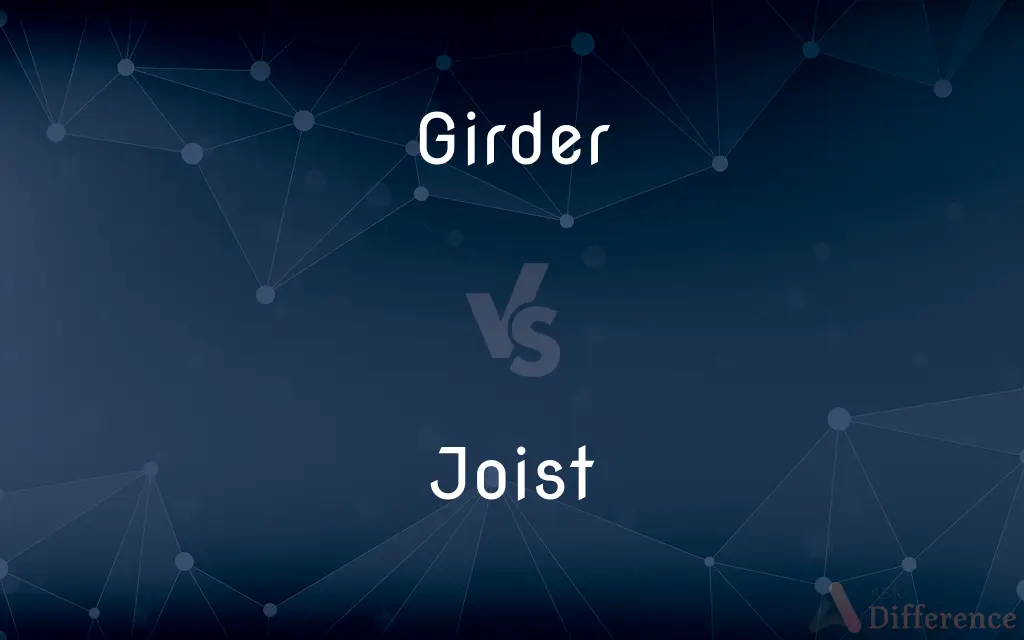Girder vs. Joist — What's the Difference?
By Tayyaba Rehman — Updated on November 2, 2023
A girder is a large beam that supports smaller beams or joists; a joist is a smaller beam that supports floors or ceilings and spans between girders or bearing walls.

Difference Between Girder and Joist
Table of Contents
ADVERTISEMENT
Key Differences
Girders are the main horizontal supports of a structure, and joists are the smaller beams that run between girders. Girders are typically larger and bear the load of joists.
A girder is designed to support heavy loads and can be made of steel, concrete, or wood. Joists, placed on or supported by girders, are essential for distributing the weight they carry.
Girders form the structural backbone, often supporting walls or floors, while joists are laid out in parallel series to support the surface of the floor or ceiling.
Joists rely on the strength of girders to span open spaces, usually arranged at regular intervals. Girders often require special design considerations due to their load-bearing role.
While a girder may support structural elements like joists, the joists themselves provide a mounting point for the floor or ceiling material, such as plywood or plasterboard.
ADVERTISEMENT
Comparison Chart
Size
Larger and stronger
Smaller and numerous
Function
Main support beam for joists or beams
Supports the floor or ceiling surface
Placement
Often horizontal, at greater spans
Spaced at regular intervals between girders
Load Bearing
Designed to carry larger loads
Designed to spread out a load over a surface
Material
Typically steel, concrete, or large wood
Usually made of wood or lightweight steel
Compare with Definitions
Girder
Used to support a major load.
Additional girders were required to fortify the bridge's structure.
Joist
Typically part of the flooring structure.
The squeaky floors indicated some of the joists needed reinforcement.
Girder
The main horizontal support of a structure.
The old warehouse's girders were exposed, giving it a rustic charm.
Joist
Often arranged in repetitive patterns for support.
The architect designed the building with exposed joists for an industrial look.
Girder
A beam made of metal or wood.
They used a crane to lift the massive girder into place.
Joist
A length of timber or steel supporting part of the structure of a building.
The carpenters secured the joists before laying the floorboards.
Girder
A primary beam of a building’s framework.
The girders were inspected for integrity after the earthquake.
Joist
Parallel beams that support decking or flooring.
The deck’s stability depends on the spacing and strength of its joists.
Girder
A large beam that supports other beams.
The steel girder was installed to provide support for the new roof.
Joist
A beam that holds up the floor or ceiling.
We had to replace several rotted joists in the old house.
Girder
A girder is a support beam used in construction. It is the main horizontal support of a structure which supports smaller beams.
Joist
A joist is a horizontal structural member used in framing to span an open space, often between beams that subsequently transfer loads to vertical members. When incorporated into a floor framing system, joists serve to provide stiffness to the subfloor sheathing, allowing it to function as a horizontal diaphragm.
Girder
A large iron or steel beam or compound structure used for building bridges and the framework of large buildings
The tower is made of steel girders criss-crossed to make it stronger
Joist
Any of the wood, steel, or concrete beams set parallel from wall to wall or across or abutting girders to support a floor or ceiling.
Girder
A beam, as of steel, wood, or reinforced concrete, used as a main horizontal support in a building or bridge.
Joist
To construct with joists.
Girder
A beam of steel, wood, or reinforced concrete, used as a main horizontal support in a building or structure.
Joist
A piece of timber or steel laid horizontally, or nearly so, to which the planks of the floor, or the laths or furring strips of a ceiling, are nailed.
Girder
One who girds; a satirist.
Joist
(transitive) To fit or furnish with joists.
Girder
One who girds; a satirist.
Joist
To fit or furnish with joists.
Girder
One who, or that which, girds.
Joist
Beam used to support floors or roofs
Girder
A main beam; a stright, horizontal beam to span an opening or carry weight, such as ends of floor beams, etc.; hence, a framed or built-up member discharging the same office, technically called a compound girder. See Illusts. of Frame, and Doubleframed floor, under Double.
Girder
A beam made usually of steel; a main support in a structure
Common Curiosities
Are joists only made of wood?
No, joists can be made of wood, steel, or engineered materials designed for specific structural needs.
Can a girder be used horizontally and vertically?
Girders are typically used horizontally but can also be used vertically as columns in some structures.
Can girders be part of a bridge structure?
Yes, girders are often key components in bridge construction, providing support across large spans.
Do girders require special installation techniques?
Yes, due to their size and weight, girders often require cranes and specialized equipment for installation.
What is a joist?
A joist is a smaller beam that runs in parallel to support floors, ceilings, or decks.
Do girders need support?
Yes, girders typically rest on columns or piers, which transfer the load to the foundation.
How far apart are joists placed in construction?
The spacing of joists varies based on their material and the load they need to support, but they are commonly placed 16 to 24 inches apart.
What is a girder?
A girder is a large primary beam used in construction to support secondary beams or joists.
How do girders and joists work together?
Girders provide the main support for the structure's framework, while joists are laid across girders to support the surface area of the floor or roof.
Is it possible to replace a damaged joist?
Yes, a damaged joist can be replaced or reinforced, depending on the extent of the damage and accessibility.
How are joists selected for a project?
Joists are chosen based on the load they must support, the span they will cover, and the type of material used.
Are joists visible in finished buildings?
Joists are usually covered by flooring or ceiling materials and are not visible in finished buildings, although they may be left exposed for aesthetic reasons.
How does the length of a girder affect its strength?
Longer girders must be stronger or have additional support to prevent sagging and to handle the increased load.
Can girders be decorative as well as functional?
While girders are primarily functional, they can also be designed to be decorative elements in a structure.
What happens if a joist fails?
If a joist fails, it can lead to sagging or collapse of the supported floor or ceiling, and must be addressed immediately to maintain structural integrity.
Share Your Discovery

Previous Comparison
Diagnostic vs. Diagnosis
Next Comparison
Cash vs. ChequesAuthor Spotlight
Written by
Tayyaba RehmanTayyaba Rehman is a distinguished writer, currently serving as a primary contributor to askdifference.com. As a researcher in semantics and etymology, Tayyaba's passion for the complexity of languages and their distinctions has found a perfect home on the platform. Tayyaba delves into the intricacies of language, distinguishing between commonly confused words and phrases, thereby providing clarity for readers worldwide.














































